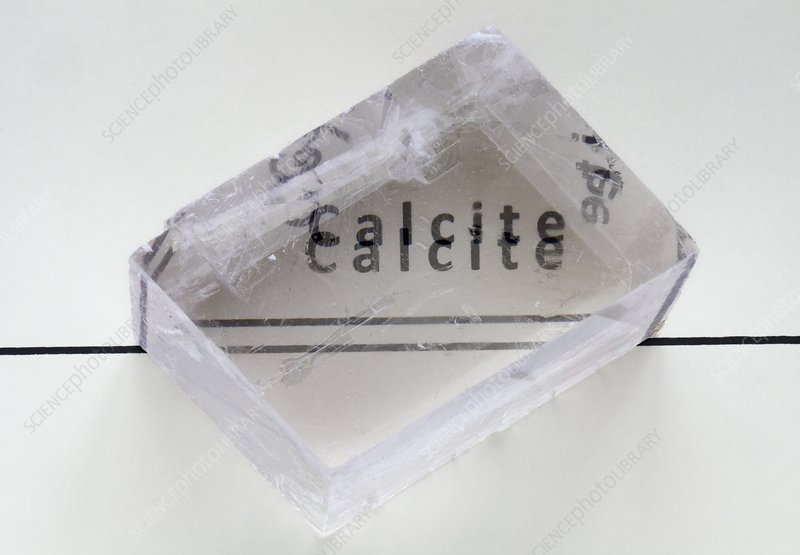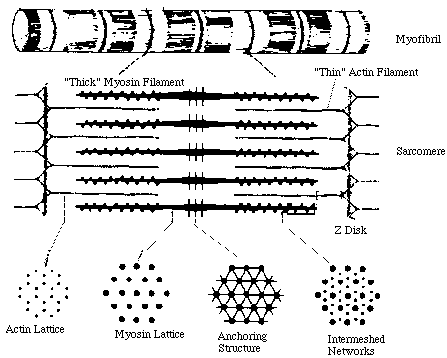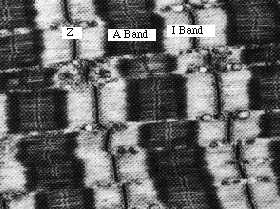I love reading about how old scientists worked, because it's so easy to bridge our normal, everyday reality to their discoveries. Unlike nowadays, there wasn't so much scaffolding you had to climb before you could understand what they were talking about.
This (above) is muscle tissue, similar to what physician Ernst Brücke might have seen in his microscope in the mid-1800s. (There weren't microscope pictures back then.) I was astonished to discover than von Brucke worked out how muscles "work out" from looking at images like this. I was doubly surprised to learn that his contemporaries discarded his theories, and that he was only decisively proven right a hundred years later.
Here's how to understand what Brucke proposed. Put your hands in front of you, and interleave your fingers. If your left hand was made of actin, and your right hand made of myosin, your two hands together would form the littlest bit of skeletal muscle, called a sarcomere (from Greek sarx, sark - ‘flesh’ + meros ‘part’). Sliding your fingers together, or apart, is exactly what a sarcomere does when it stretches or shrinks. This explanation of how muscles work is called sliding filament theory.

In those days, nearly everything in the human body was an utter mystery. For example, many physicians used to think that sperm contained packaged inside of it another, smaller, man. Light microscopes were deployed to check this, among other things, with the idea that any question could be answered given enough magnification.
Anyway, the first person to really do this, Ernst Wilhelm von Brücke, pretty much got the answer right on the first try back in 1858. He put together a couple facts he worked out from the light microscope. He noticed that the light was "duplicated" (kind of like a double image) when seen through a muscle cell. This, he knew, was something that only happens when light passes through a material with a preferred axis.
To help visualize what I'm about to tell you, it helps to use your hands. Put your them in front of you, and interlace your fingers. If your left hand was made of actin, and your right hand made of myosin, your two hands together would form the littlest bit of skeletal muscle, called a sarcomere (from Greek sarx, sark - ‘flesh’ + meros ‘part’). Sliding your fingers together, or apart, is exactly what a sarcomere looks like when it stretches or shrinks.
The actin (still your left hand) and the myosin (right) pull against each other to create contractile force. Return to your hands again, and stretch the "muscle" apart so that your fingers are barely touching.
The contractile force that a muscle can produce is proportional to how much those fibers overlap. This is why it's hard to do a bicep curl starting with your arms fully extended. It works the other way, too. When the muscle is fully contracted, the fibers can't pull themselves together anymore. The maximum contractile force is about when the filaments totally overlap, no more and no less.

- what is the story? it's the story of smart people figuring things out by just looking at them under a microscope. then other smart people thinking the previous smart humans were wrong. they thought the people were wrong because they had fancy new technology, and doubted what the old people were doing. they also made some assumptions based on new ideas (darwin's ideas) that turned out to be wrong. they piggybacked off new ideas in biochemistry to assert that the important things could not be seen under a microscope, and had to be inferred biochemically. in the end, it was just another microscope, and the benefit of hindsight, that showed us how muscles work.
It's a lovely discovery and, if you're like me, you might be wondering when exactly all of this was figured out. Biased coming from physics, I thought maybe someone had predicted the existence of the filaments, maybe based on some kind of indirect evidence. But no -- it was just a custom-built, super-powerful microscope that settled the question. You could see the actin and myosin interleaved. It left no room for debate.
Oddly, the scientists of 1850 weren't that different from the scientists of 1950. They had microscopes too, and despite being only able to see dark and light bands under a light microscope, made an astounding number of inferences that basically lead them to the door of understanding how muscles worked. But science would take a number of turns that would stand in the way of sliding filament theory being disocvered.
I couldn't help but feel like maybe this
And they did... but in 1800s. And beyond that point, science, somehow, did everything in its power to go backwards and overwrite the progress that that the previous scientists had made.
In physics, sometimes someone theorizes about a particle, and then someone else does an experiment thirty years later to prove that it really exists. Or someone comes up with a beautiful argument from first principles, like Watson and Crick did when they proved that the smallest viruses should have symmetric shells, just based on the length of their RNA. Maybe someone inferred the existence filaments in a similar way. But it didn't happen like that. Like, at all.
I was surprised to learn that it just came down to microscopes. In the 1950s, Huxley and his team figured out how to send lasers through muscle tissue and saw the filaments in black and white. If it was that easy, how come it took so long to figure out?
I learned that sliding filament theory was mainly worked out in the 1950s.
This all got worked out in the 1950s, by Huxley's crystallographic experiments on muscle tissue.
ll the pieces to understanding that muscles were made of little sliding filaments were in place by the mid-1800s.
How come it wasn't discovered sooner?
Heisenberg and Dirac were starting out on relativistic quantum field theory around three decades before Huxley figured out that muscles were made of two kinds of rods sliding back and forth.
In the mid-1800s, physicians were extremely curious about how muscles could contract, and couldn't wrap their heads around it. They used the only reasonable tool for the job: the light microscope. I keep having to remind myself that people figured out how to make microscopes that could look at cells back in the 1600s. It's one of those facts that I just can't get used to.
Anyway, the first person to really do this, Ernst Wilhelm von Brücke, pretty much got the answer right on the first try back in 1858. He put together a couple facts he worked out from the light microscope. He noticed that the light was "duplicated" (kind of like a double image) when seen through a muscle cell. This, he knew, was something that only happens when light passes through a material with a preferred axis.
I first heard of "sliding filament theory" presented as a pretty modern theory, and it makes up a pretty fundamental
The strength of a muscle is proportional to how much the fingers overlap. When you stretch a muscle out to the max (pull your fingers almost
All of this was conclusively worked out in the 1950s by shining tiny beams of light into muscle tissue. Thing was, someone could have worked this out, probably, in the 1850s, but science went wrong.
Incredibly, everything
There are materials like, clay, sand, and air, that don't have a preferred direction. There are other materials, like paper, which do. To see this for yourself, take a typical sheet of printer paper and try to tear it along the long axis and then along the short axis. Along the long axis, it tears easily, because the tiny paper fibers align along this axis.
Crystals
It was known back in the 1800s that if you had a material that looked
“When you're thinking about something that you don't understand, you have a terrible, uncomfortable feeling called confusion. It's a very difficult and unhappy business. And so most of the time you're rather unhappy, actually, with this confusion. You can't penetrate this thing. Now, is the confusion's because we're all some kind of apes that are kind of stupid working against this, trying to figure out [how] to put the two sticks together to reach the banana and we can't quite make it, the idea? And I get this feeling all the time that I'm an ape trying to put two sticks together, so I always feel stupid. Once in a while, though, the sticks go together on me and I reach the banana.”
